![]() 1st Battalion 22nd Infantry
1st Battalion 22nd Infantry ![]()
The Ramaien Expedition 1904
![]()
Campaign Streamer awarded to the 22nd Infantry for its service in Mindanao 1904-1905
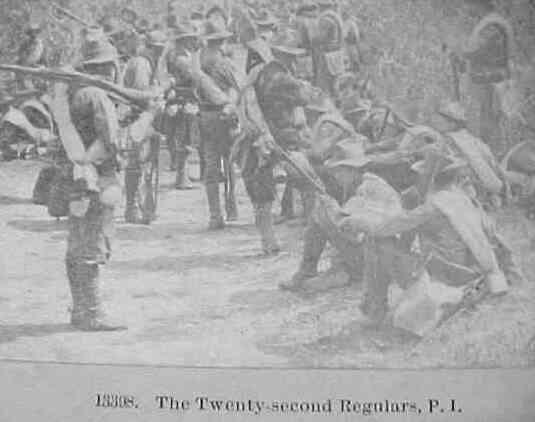
The 22nd Infantry in the Philippines
From a stereoview by B.W. Kilburn-Littleton N.H.
THE RAMAIEN EXPEDITION
December 17, 1903, while duck hunting, a small
party of officers and soldiers from Marahui were fired upon by
hostile Moros near Ramaien.
Repeated demands were made upon the sultan of this district for
the surrender of the hostile Moros; but although the assailants
were well known,
no attention was paid to the demands. An expedition was
accordingly arranged to arrest the sultan. The territory of
Ramaien was known to be disaffected.
At three o'clock on the morning of January 22,
1904, the first battalion of the regiment, Major J. S. Parke
commanding, embarked in row boats
and native vintas at Marahui and proceeded toward Ramaien, about
seven miles across the northern end of the lake. Five men from
each company
of the third battalion accompanied the expedition. Companies B
and D were landed at Baringbingan, north of Ramaien, in order to
get in rear
of the disaffected territory; companies A and C and two boats,
containing, respectively, a Gatling gun and a Vickers-Maxim gun,
proceeded to Ramaien.
At the mouth of the river, the command was met
by several minor chiefs, and after a parley, the companies,
preceded by the gunboats,
were rowed up the stream. The actions of the natives that had
been taken with the companies plainly indicated that an attack
was meditated.
Raising their red umbrellas, they remained standing until ordered
to sit. They shouted continuously to Moros along the banks of the
river,
finally admitting that, although they themselves were friendly,
there were many bad Moros in the territory.
Ramaien consisted of several miles of cottas
along the north bank of the river. Ditseen was similarly built
upon the south bank.
The river at this time was not more than seventy-five feet wide,
and was well commanded by the walls of the cottas.
The boats were running a narrow gauntlet. At any moment a
murderous, short range fire might be opened upon them.
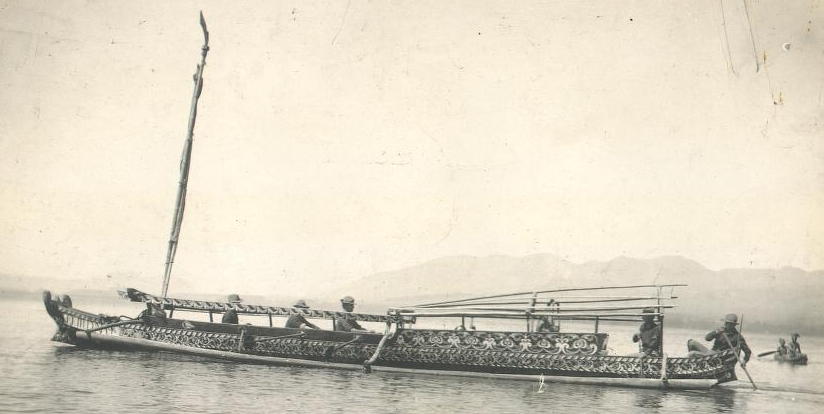
US Soldiers rowing a Moro vinta.
Major Parke filled these types of boats with Soldiers from 1st
Battalion, and used two other row boats
to hold the Gatling gun and Vickers machine gun, and rowed the
seven miles across Lake Lanao
to Ramien. Companies B and D were landed a short distance from
the village to advance upon it from the rear,
while Companies A and C, along with the boats carrying the rapid
fire guns, moved directly to the mouth of the river
along which the village of Ramien was situated.
From the Parker Hitt photograph collection, University
of Michigan
This photo also appeared in the 1904 Regimental History
Before reaching the main cottas, detachments
were landed. On each side of the river, between the cotta walls
and the stream was a narrow trail,
along which the detachments, in single file, kept pace with the
leading boat. While moving up the river, many armed Moros were
seen running
from cotta to cotta; they carried rifles, kampilans, and krises,
and were evidently hastening to a large cotta at the upper end of
the town.
As this cotta was a menace to the boats, the land detachment
approached to investigate it. Its narrow entrance was closed by a
high gate of bamboo;
within were a number of Moros aiming their rifles at the command.
Led by two officers, a dash was made into the cotta.
Hardly had they entered before the two officers were shot down.
These were the first shots fired.
The battalion had seen many armed Moros, but in pursuance of a
peaceful policy, had refrained from shooting.
Orders required the arrest of the sultan, if possible, without
the shedding of blood.
The few men that had gained entrance to the
cotta gallantly covered the Moros until the wounded officers were
without;
they then retired about twenty yards, and under cover of the
cotta walls, the detachment was reinforced,
and immediately charged and captured the cotta.
Escaping Moros were driven from cotta to cotta
before they had time to form and make a stand.
This method of attack was continued until there was danger of
firing into the other command, which was slowly forcing its way
through the swamps to the rear of the town. All firing then
ceased; trumpet calls kept each command informed of the position
of the other command until a junction was effected.
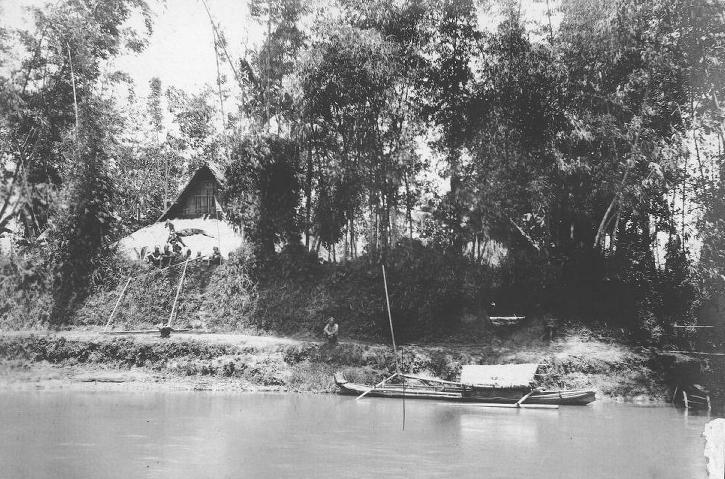
Cotta on the Ramaien River
Earthen walls line the bank, and an opening in the walls can be
seen just above the boat in the river.
A hut, or structure is beyond the walls in the left of the photo,
with Moros sitting on the wall
in front of it.
From the Parker Hitt photograph collection, University of Michigan
The battalion, assisted by the gunboats, then
drove the enemy several miles up the river, landed, moved down
the river,
and destroyed the defenses of the town as far as possible. In
this, as in all other engagements, the troops were greatly
hampered
by the proximity of friendly Moros. Ditseen, opposite Ramaien,
flew many American flags. It also delivered many hostile shots,
but the troops were compelled to assume that these shots were
fired by Ramaien natives fleeing across the river.
Ditseen, displaying American flags, was spared, although in its
territory were seen many natives bearing rifles.
The leniency of American troops is truly wonderful. As the
battalion embarked, the rear guard was fired upon from lantacas
and rifles
in a cotta that had been spared in the advance. In this manner
was American leniency appreciated by the Moro.
The battalion returned to Marahui at 4:30 p. m.
The Moro loss in the engagement was about twenty-five killed;
and although the direct object of the expedition, the arrest of
the sultan, was not accomplished, this worthy afterward presented
himself at Marahui,
and made overtures for peace. On a subsequent expedition of the
regiment through this territory, this same sultan gave ample
proof of his desire for friendship.
Killed in action:
2nd Lieutenant Campbell W. Flake, Commanding Officer Company A
Wounded in action:
2nd Lieutenant William E. Roberts,
Quartermaster 1st Battalion
Private Charles Foy, company A.
|
2nd Lieutenant Campbell W. Flake Killed in action at Ramaien January 22, 1904 Photo taken at Fort Reno, Indian
Territory 1903. |
GENERAL ORDERS No. 1, HEADQUARTERS 22ND
U.S. INFANTRY.
CAMP MARAHUI, MINDANAO, P. I. January 23rd, 1904.
It has become the sad duty of the
Regimental Commander to announce the death of an officer:
2nd Lieutenant Campbell W. Flake, 22nd infantry.
Killed in action at Ramaien river, Lake Lanao, Mindanao January
22, 1904, against savage and treacherous Moros.
He died a soldier's death. Shot dead on the field of battle.
His record is closed. He has given his life to his country.
Brave, courteous, prompt, willing, and
efficient were the qualities which endeared him to all.
The regiment has lost a fine young officer, cut down in the prime
of his splendid physical strength. His loss is deeply mourned.
To the widow and orphan sincerest sympathy is extended.
Lieut. Flake was born October 31, 1875. Enlisted June 17, 1898,
in the 3rd U. S. vol. infantry, and served as first sergeant
until May 2, 1899, when he was mustered out. During this time he
served in Cuba from August, 1898, until April, 1899.
Commissioned 2nd lieutenant of infantry on July 15, 1901, and
assigned to 27th infantry.
Transferred to 22nd infantry, December 2, 1901, and assigned to
company A, in which organization he served until killed.
As a mark of respect officers of the regiment will wear the usual
badge of mourning for thirty days.
BY ORDER OF COLONEL WYGANT:
R. L. HAMILTON,
Captain, 22nd Infantry Adjutant.
|
Major John S. Parke Commanding officer 1st
Battalion 22nd Infantry Photo from the Army and Navy Register January 6, 1906 |
The following is a description of the Ramaien
Expedition as told by the commander of the Expedition
Major John S. Parke:
"Companies B and D
were landed a short distance from Ramaien, with orders to advance
on the village from the rear. Companies A and C, along with
two rowboats carrying a Gatling gun and Vickers-Maxim gun,
continued on to Ramaien.
At the mouth of the
river, leading to the village, we were met by a number of minor
chiefs. The nervous chatter, and agitated behavior of the
natives,
plainly indicated that an attack was being meditated. With red
umbrellas raised over their heads, the tribesmen dashed excitedly
about—arguing among
themselves until their leaders shouted for them to sit down.
After a short parley with
a couple of dattos, we paddled upstream— the gunboats
leading the way. Along the route, the 'umbrella-men' screamed
continuously at other Moros on the opposite bank of the river.
The dattos had informed us, that although they themselves were
friendly, the 'bad' Moros
were the ones across the waterway.
Ramaien consisted of
several miles of cottas along the north bank of the river.
Another village, Ditseen, was similarly constructed on the south
shore.
The river at this point was well commanded by the solid wall of
cottas. Our boats would be running a narrow gauntlet. At any
moment a short range,
murderous fire could be opened up on us.
I had noticed that on
each side of the river—between the cotta walls and the
water—a narrow trail followed the bank. Detachments of
soldiers were landed
and moved in single file—keeping pace with the lead boat.
As we proceeded slowly
upriver, many heavily armed Moros could be seen running from
cotta to cotta. They carried rifles and knives, and evidently
were hurrying to a large fortress at the upper end of town. Since
this obstacle could be a menace to our boats, the land detail was
directed to approach
and investigate the formidable looking bastion.
The cotta's entrance had
been closed by a tall bamboo gate. Within the fort, a number of
Moros could be seen with their rifles aimed at our soldiers
advancing along the shore. On command, Lieutenants Campbell Flake
and William Roberts, leading their men, rushed the cotta.
The two officers were immediately cut down.
The stunned soldiers
attempted to deploy along the path—there was no room. They
splashed into the water—and from waist high positions
dueled the Moro riflemen. While the battle was going on, a few
troopers braved enemy bullets and dragged the wounded officers to
safety.*
The detachment then retreated to protective cover at the base of
the bamboo walls.
Reinforcements were
rushed ashore. The angry Americans—spurred on by
revenge—charged the cotta. No quarter was given or asked.
The Moros quickly realized they were not dealing with the
Spaniards, and attempted to flee.
The enemy was not
prepared for this kind of furious assault. There was no time to
make a stand as they were chased from one cotta to another.
The attack was pursued until it became evident that there was
danger of our firing into the other command—which was slowly
forcing its way
through the swamps to the rear of the town. Cease firing was
sounded, and trumpet calls kept each unit informed of the
position of the other
until a junction was effected.
The battalion, assisted
by the machine gun boats, drove the Moro warriors several miles
from the village. The balance of troops, still aboard canoes,
were put ashore and moved downriver—destroying any cottas
still occupied by the enemy.
During this engagement,
our men were hampered by the proximity of supposedly friendly
Moros. American flags suddenly appeared over the cottas
at Ditseen. Many hostile shots were fired from the purported
sympathetic side of the river. However, our trusting soldiers
assumed that these bullets
came from Ramaien natives who escaped across the stream. Ditseen
was spared—although a large number of their tribesmen were
observed carrying rifles.
As the battalion
reembarked aboard the canoes, the rear guard came under fire from
a cotta that had not been completely destroyed.
The Gatling gun finished the job, and the weary troops returned
to Camp Marahui at five o'clock that afternoon." ¹
*
Two of the soldiers who covered and retrieved Lieutenants Flake
and Roberts were awarded Certificates of Merit.
They were Corporal Travis T. Bryan and Quartermaster Sergeant
Edward J. Zink.
The Army Register recorded that on November 16, 1904 Sergeant Travis T. Bryan was awarded a Certificate of Merit by the following citation:
"...action on the Ramien River,
near Lake Lanao, Mindanao, P. I., January 22, 1904, gallant and
meritorious conduct in action, while a corporal,
company A, 22d U. S. Infantry, in placing himself in the gateway
of a Moro fort where two officers had just been wounded by the
fire of
the enemy within the fort, which exposed position he maintained,
keeping up a fire on the enemy, thus diverting their fire from
one of the
wounded officers who had fallen forward within the fort and
enabling that officer to reach a place of safety. [525621, A. G.
O]
Travis T. Bryan was born in
Chattanooga, Tennessee in March 1877. He enlisted in the Army for
a period of 3 years on June 24, 1900
at Little Rock, Arkansas. His enlistment record indicated he
stood 5 feet 7 inches tall, had blue eyes, sandy hair and a light
complexion.
His previous occupation was listed as Fireman. He was assigned to
Company A 22nd Infantry on October 29, 1900 and shipped overseas
to join his Company which was then in the Philippines. After
serving with the 22nd Infantry in the Philippines he returned
with the Regiment
to the United States where upon expiration of his enlistment he
was discharged as a Corporal at Fort Reno, Indian Territory on
June 23, 1903.
Bryan reenlisted as a Corporal in
Company A at Fort Reno on June 24, 1903. He returned with the
Regiment for a second deployment to the
Philippines and was discharged from this enlistment as a 1st
Sergeant at Alcatraz Island, California on June 23, 1906. He
reenlisted the same
day at Alcatraz Island as a 1st Sergeant in Company A. He was
transferred to Company F as a Private on January 8, 1908 and was
discharged from
this enlistment as a Private on February 22, 1908 at the Presidio
of Monterey, California. He reenlisted in Company F as a Private
on February 23, 1908
at the Presidio of Monterey. On may 31, 1910 while serving with
Company F in Alaska Bryan purchased a discharge from this
enlistment through
Special Orders 83 dated April 26, 1910. He had served nearly 10
years in the 22nd Infantry, rose to the rank of 1st Sergeant and
left as a Private.
|
Quartermaster Sergeant
Edward J. Zink of Company A 1st Battalion 22nd Infantry The citation for his
Certificate read exactly as that of Travis T. Bryan above
with Years later his award was converted to the Distinguished Service Cross. The citation for that award is below: |

D.S.C. citation from Home Of Heroes website
Edward J. Zink was born in Bavaria,
Germany in February 1877. He enlisted as a Private for a period
of three years in the U.S. Army
on October 3, 1898 at Louisville, Kentucky. On October 5, 1898 he
was assigned to and joined Company A 22nd Infantry at Fort Crook,
Nebraska. His enlistment record indicated he stood 5 feet 11 ¾
inches tall, had dark brown hair, brown eyes and a light
complexion. His
previous occupation was listed as Driver. By December of 1899
Zink had been promoted to Corporal. Zink was discharged from this
enlistment as a Corporal on October 2, 1901 at Manila,
Philippines with a character reference of Excellent.
On October 3, 1901 Zink re-enlisted in
Company A 22nd Infantry at Manila for a period of three years. On
this enlistment record his previous
occupation was listed as soldier. By October of 1902 Zink had
been promoted to Sergeant. By June of 1904 he had been promoted
to
Quartermaster Sergeant. Zink was discharged from this enlistment
as a Quartermaster Sergeant on September 23, 1904 at Angel
Island,
California with a character reference of Excellent.
On October 3, 1904 Zink re-enlisted as
a Private in Company A of the 30th Infantry at Louisville,
Kentucky. He joined his Company on
October 12, 1904 at Fort Crook, Nebraska. On this enlistment
record his previous occupation was listed as soldier. Zink was
discharged
from this enlistment as a Corporal on December 14, 1906 by
Special Order at Fort Crook, Nebraska with a character reference
of Excellent
and a notation of Service Honest and Faithful.
Zink served a total of just over eight
years in the Army, six of those years with the 22nd Infantry. He
went with the 22nd Infantry
on both of its deployments to the Philippines and saw action in
both the Philippine Insurrection and Moro Wars. He finished the
last
two years of his Army career with the 30th Infantry on stateside
garrison duty at Fort Crook, Nebraska.
Colonel Henry Wygant, Commander of the 22nd
Infantry wrote the following short After Action Report of the
Ramaien Expedition
and included it on the official Return of Casualties of the 22nd
Infantry for January 22, 1904:
In compliance with G.O.
No. 5 c.s., this station, Companies A.B.C.& D. 22d Infantry,
Major John S. Parke Jr., 22nd Infty., Commanding, left Camp
Marahui
at 2:00 A.M. January 22, 1904 for Ramaien River, to capture or
kill the Sultan of Ramaien and two of his people. The Command
proceeded by boat across
Lake Lanao, reaching the mouth of Ramaien River soon after day
light. Major Parker with companies A. & C. proceeded up the
River, while companies B. & D. ,
under Major R. L. Bullard, 28th Infty., Civil Governor of the
Province of Lanao, who had accompanied the expedition, made a
detour to strike Ramaien's
Cottas from the north. About 8 A.M. our troops were fired upon
and all were soon actively engaged. The Moros were driven from
their cottas, 23 are known
to have been killed. Five cannon, five rifles, a considerable
number of Moro arms and one revolver were captured. Their cottas
were destroyed as far as
practicable. Troops returned to Camp marahui at 4:30 P.M. -
Distance travelled about 20 miles.
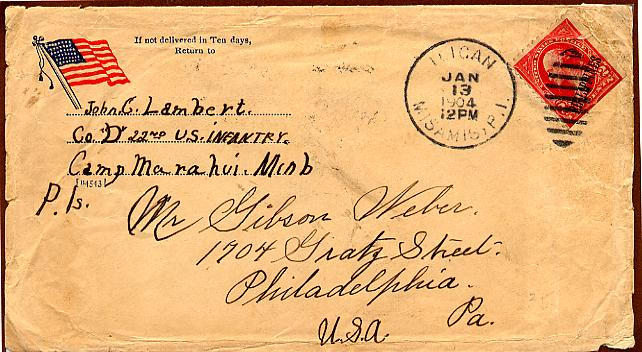
Letter from Private John G. Lambert of
Company D 22nd Infantry postmarked at the Military Station at
Camp Marahui, Iligan, Mindanao, Philippine Islands on January 13,
1904, nine days before the Ramaien Expedition.
John G. Lambert was born in
Philadelphia, Pennsylvania in 1882. He enlisted in Company D 22nd
Infantry on
February 15, 1902. Lambert was with Company D during the Ramaien
Expedition of January 22, 1904.
Philatelic cover courtesy of
Briefmarken-Sammlung/
stamp collection "PHILIPPINEN"
The Return of the 22nd Infantry for the month
of February 1904 noted the following entry under the heading
of Record of Events:
Companies "E",
"G" and "H", stationed at Camp Pantar took
part in defense of that Camp during night attacks by hostile
Moros,
at 11:00 P.M., Feb. 13th and at about 3:00 A.M. Feb. 14th ---
Casualties: Pvt. Walter W. Woods, Co. "H" 22d Infty.,
severe cut from kris, on left forearm, completely severing the
Ulna and tendon.
Pvt. Chester A. Collett, Co. "H" 22d Infty., gun shot
wound in left thigh.

Above: The casualty report of the 22nd
Infantry for the action occurring February 13th and 14th, 1904.
Private Walter W. Woods is listed on Line 1 as having suffered a
cut on his left arm by a Bolo.
(The Bolo and Kris were edged weapons used by the Moros and the
names were used interchangeably
in reports of injuries inflicted by the Moros using edged
weapons.)
Private Chester A. Collett is listed on Line 2 as having suffered
a gun shot wound to his left thigh.
Chester A. Collett listed in Line 2 of
the above report was born in Leadville, Randolph County, West
Virginia on March 30, 1880.
He enlisted as a Private in the U.S. Army for a period of three
years on June 19, 1902 at Elkins, West Virginia. Collett was
assigned to
and joined Company H 22nd Infantry on August 14, 1902 at Fort
Crook, Nebraska. His enlistment record indicated he stood 5 feet
9 inches
tall, had light brown hair, blue eyes and a fair complexion. His
previous occupation was listed as Carpenter. Collett deployed
with the 22nd
Infantry to the Philippines at the end of 1903. In May of 1905 he
returned to the United States where he was discharged as a
Private on
July 26, 1904 at Angel Island, California with a character
reference of Excellent. Chester Arthur Collett died in 1953 at
the age of 73
and is buried in Elkins, Randolph County, West Virginia.
Walter W. Woods listed in Line 1 of the
above report was born in Stockton, San Joaquin County, California
on August 14, 1881.
He enlisted as a Private in the U.S. Army for a period of three
years on February 10, 1902 at Worcester, Massachusetts. Woods
was assigned to and joined Company H 22nd Infantry on March 23,
1902 at Fort Crook, Nebraska. His enlistment record indicated
he stood 5 feet 6 inches tall, had dark brown hair, brown eyes
and a ruddy complexion. His previous occupation was listed as
Farmer.
Woods deployed with the 22nd Infantry to the Philippines at the
end of 1903. He was admitted sick into the hospital in Manila on
July 9, 1904 and was transferred to the Casual Detachment of the
22nd Infantry at the Presidio at San Francisco, California on
September 3, 1904. Woods was discharged as a Private on February
9, 1905 at Fort Bayard, New Mexico with a character reference
of Excellent. Walter W. Woods died in 1950 at the age of 69 and
is buried in San Antonio, Texas.
|
On November 1, 1904 Private
Walter W. Woods, of Company H 22nd Infantry, was awarded
a Certificate of Merit
Years later his award was converted to the Distinguished Service Cross. The citation for that award is below: |

Note: In the above citation the
location is incorrectly given as Camp Santas. There was no Camp
Santas and the citation
should read Camp Pantar.
D.S.C. citation from Home Of Heroes website
Shortly before midnight, February 27, 1904,
Moros made an attack upon the companies at Pantar. Shots were
fired into camp,
and one sentinel was cut with a kampilan. Several nights later, a
similar attempt, probably to steal rifles, was made at Marahui.
March, 1904, the regiment carried off the
honors in the department athletic competition at Zamboanga.
In addition, Private George W. Smith, company K, won first place
as the best all-around athlete.
The regimental ball team was so successful in this meet that it
was sent to Manila in June;
while there it defeated the winning nine of the Luzon
competition.
The Annual Department athletic contest was held at Zamboanga March 24-28, 1904. It featured both conventional activities, such as field and track, baseball, and football, but also field exercises, such as field stripping, running in formation with packs, dissembling, reassembling artillery pieces, etc.
Results were: 22nd infantry-54 1/2 points 14th Cavalry-----34 points 23rd Infantry-10 1/2 points 17th Infantry-----10 points 17th Battery, FA--3 points
In addition, Pvt. George W. Smith of Co. K, 22nd was named "best all-around athlete." ²
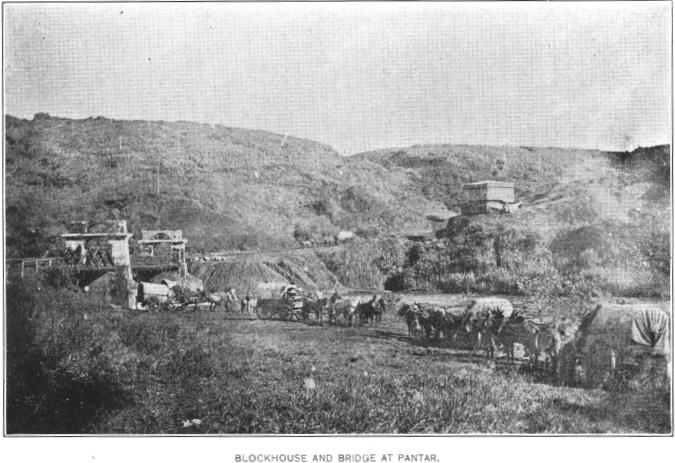
The bridge (left) and blockhouse (right) at Pantar
Photo from the 1904 Regimental History
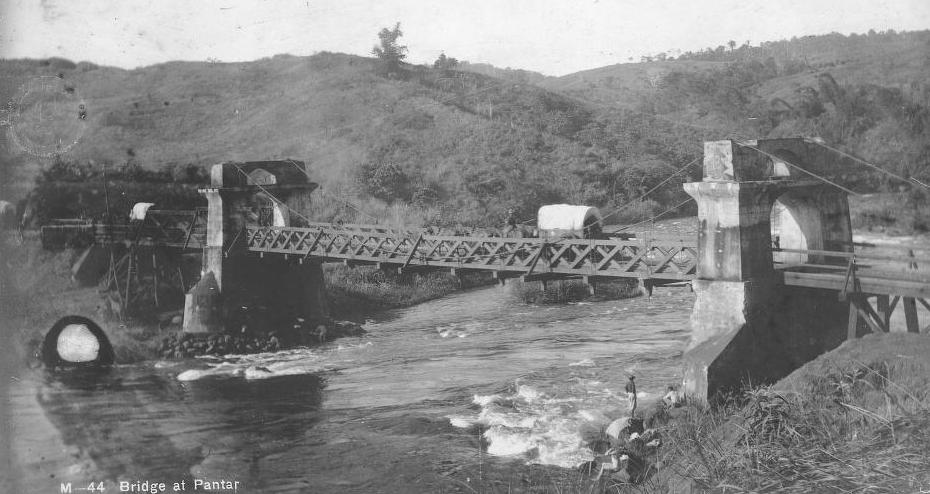
The bridge at Pantar
Supply wagons move across the bridge and Soldiers can be seen
washing and bathing at the feet of the bridge on both sides of
the river.
From the Parker Hitt photograph collection, University of Michigan
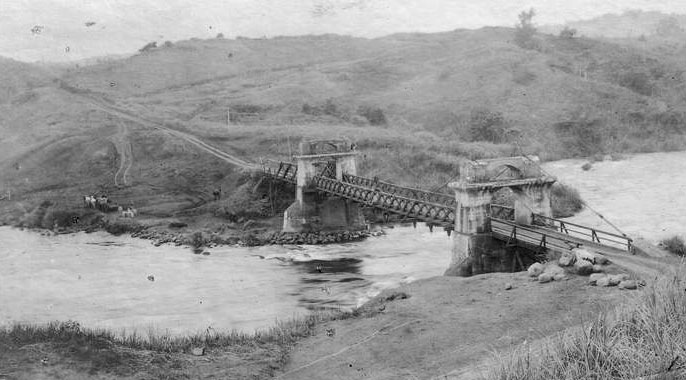
Another view of the bridge at Pantar over the Agus River, as seen from the blockhouse.
First built in February 1895, the
Pantar Bridge was burned by the retreating Spanish during their
fight with the Americans,
and then rebuilt over 4 months -- from 18 May – 30 September
1903 – by Company E, 2nd Battalion US Engineers.
Information from Matthew Westfall
**********************
¹ Combat Diary EPISODES FROM THE HISTORY OF THE
TWENTY-SECOND REGIMENT, 1866-1905
by A. B. Feuer Praeger Publishers, New York, N.Y. pp.159-161
² Annual Reports Sec of War 1904 (by way of Bob Fulton)
Additional Sources:
22nd Infantry Regimental History 1904
Register of Enlistments in the
U.S. Army, 1798-1914; (National Archives Microfilm Publication
M233, 81 rolls);
Records of the Adjutant General’s Office, 1780’s-1917,
Record Group 94; National Archives, Washington, D.C.
Returns from Regular Army Infantry
Regiments, June 1821–December 1916. NARA microfilm
publication M665, rolls 1–244, 262-292, 297–300 of 300.
Records of the Adjutant General's Office, 1780's–1917,
Record Group 94, and Records of United States Regular Army Mobile
Units, 1821–1942,
Record Group 391. National Archives and Records Administration,
Washington, D.C.
Ancestry.com
Home | Photos | Battles & History | Current |
Rosters & Reports | Medal of Honor | Killed
in Action |
Personnel Locator | Commanders | Station
List | Campaigns |
Honors | Insignia & Memorabilia | 4-42
Artillery | Taps |
What's New | Editorial | Links |